Antibody data
- Antibody Data
- Antigen structure
- References [1]
- Comments [0]
- Validations
- Western blot [1]
- Immunohistochemistry [2]
- Flow cytometry [2]
- Other assay [3]
Submit
Validation data
Reference
Comment
Report error
- Product number
- PA5-26522 - Provider product page

- Provider
- Invitrogen Antibodies
- Product name
- HS3ST2 Polyclonal Antibody
- Antibody type
- Polyclonal
- Antigen
- Synthetic peptide
- Description
- This antibody is predicted to react with mouse and rat based on sequence homology.
- Reactivity
- Human
- Host
- Rabbit
- Isotype
- IgG
- Vial size
- 400 μL
- Concentration
- 0.5 mg/mL
- Storage
- Store at 4°C short term. For long term storage, store at -20°C, avoiding freeze/thaw cycles.
Submitted references Epigenetic inactivation of heparan sulfate (glucosamine) 3-O-sulfotransferase 2 in lung cancer and its role in tumorigenesis.
Hwang JA, Kim Y, Hong SH, Lee J, Cho YG, Han JY, Kim YH, Han J, Shim YM, Lee YS, Kim DH
PloS one 2013;8(11):e79634
PloS one 2013;8(11):e79634
No comments: Submit comment
Supportive validation
- Submitted by
- Invitrogen Antibodies (provider)
- Main image
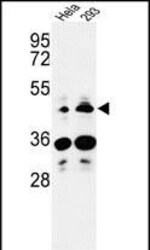
- Experimental details
- Western blot analysis of HS3ST2 in Hela, 293 cell line lysates. Samples were incubated with HS3ST2 polyclonal antibody (Product # PA5-26522). Lysates: 35 µg/lane. HS3ST2 (arrow).
Supportive validation
- Submitted by
- Invitrogen Antibodies (provider)
- Main image
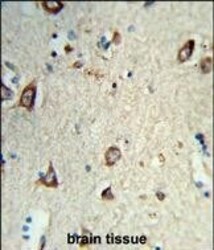
- Experimental details
- Immunohistochemistry analysis of HS3ST2 in formalin-fixed and paraffin-embedded human brain tissue. Samples were incubated with HS3ST2 polyclonal antibody (Product # PA5-26522) which was peroxidase-conjugated to the secondary antibody, followed by DAB staining. This data demonstrates the use of this antibody for immunohistochemistry; clinical relevance has not been evaluated.
- Submitted by
- Invitrogen Antibodies (provider)
- Main image
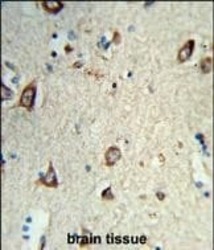
- Experimental details
- Immunohistochemistry analysis of HS3ST2 in formalin-fixed and paraffin-embedded human brain tissue. Samples were incubated with HS3ST2 polyclonal antibody (Product # PA5-26522) which was peroxidase-conjugated to the secondary antibody, followed by DAB staining. This data demonstrates the use of this antibody for immunohistochemistry; clinical relevance has not been evaluated.
Supportive validation
- Submitted by
- Invitrogen Antibodies (provider)
- Main image
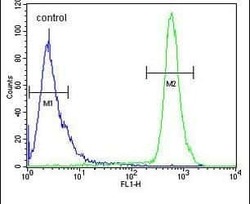
- Experimental details
- Flow cytometry analysis of HeLa cells using a HS3ST2 polyclonal antibody (Product # PA5-26522) (right) compared to a negative control cell (left) at a dilution of 1:10-50, followed by a FITC-conjugated goat anti-rabbit antibody
- Submitted by
- Invitrogen Antibodies (provider)
- Main image
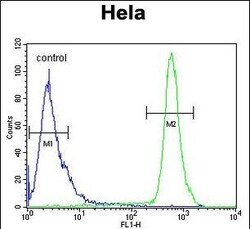
- Experimental details
- Flow cytometry of HS3ST2 in Hela cells (right histogram). Samples were incubated with HS3ST2 polyclonal antibody (Product # PA5-26522) followed by FITC-conjugated goat-anti-rabbit secondary antibody. Negative control cell (left histogram).
Supportive validation
- Submitted by
- Invitrogen Antibodies (provider)
- Main image
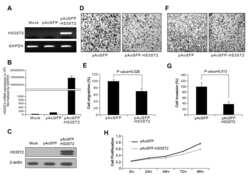
- Experimental details
- NULL
- Submitted by
- Invitrogen Antibodies (provider)
- Main image
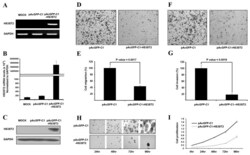
- Experimental details
- Figure 3 Induced expression of HS3ST2 inhibited cell migration, invasiveness, and proliferation. ( A - C ) pAcGFP-C1- HS3ST2 was transfected into H460 lung cancer cells. Specific overexpression of HS3ST2 compared to the empty vector was confirmed by RT-PCR (A), qRT-PCR (B), and western blotting (C). (D-G) H460 cells were seeded in a Boyden chamber with an empty vector or with one mug pAcGFP-C1- HS3ST2 in transwell migration (D & E) and invasion assays (F & G) as described in the Materials and Methods. Stained migrating cells and invading cells are shown in (D) and (F), respectively; migrating cells were measured by absorbance at 564 nm; invading cells were counted under a microscope. The results are presented relative to the in vitro migration or invasion of uninduced H460 cells (100%). (H & I) H460 cells transfected with an empty vector or pAcGFP-C1- HS3ST2 were cultured in a 96-well dish to analyze the effect of HS3ST2 on cell growth. Cell proliferation was measured by MTT assay and absorbance was measured at 570 nm. Data are presented as the mean +- standard error (SE) of triplicate experiments.
- Submitted by
- Invitrogen Antibodies (provider)
- Main image
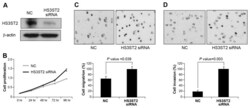
- Experimental details
- Figure 4 Knockdown of HS3ST2 expression induced cell migration, cell invasion and cell proliferation. (A) HS3ST2 siRNA was transfected into NHBE cells, and siRNA-mediated knockdown was confirmed by Western blots. (B) Cell viability was measured by MTT assay determined by evaluating the absorbance of the converted dye at a wavelength of 570 nm. (C & D) The effect of HS3ST2 knockdown on cell migration (C) and invasion (D) was also measured in NHBE cells. NC indicates untreated normal control.
 Explore
Explore Validate
Validate Learn
Learn Western blot
Western blot